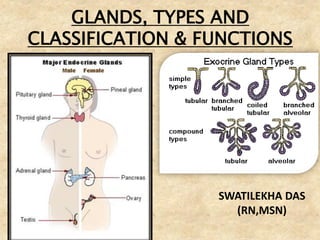Glands, Types, classification and functions(Anatomy Topic)

Anatomy Topic for B.Sc & GNM nursing students- easy explanation. what is gland? what are the types of glands? classification of glands according to structure,and according to function. functions of exocrine and endocrine glands.
Recommended
More Related Content
Slideshows for you ( 20 )
Similar to Glands, Types, classification and functions(Anatomy Topic) ( 20 )
More from Swatilekha Das ( 20 )
Recently uploaded ( 20 )
Glands, Types, classification and functions(Anatomy Topic)
- GLANDS, TYPES AND CLASSIFICATION & FUNCTIONS SWATILEKHA DAS (RN,MSN)
- DEFINITION OF GLAND A gland is a group of cells in an animal’s body that synthesizes substances (such as hormones) for release into the bloodstream (endocrine gland) or into cavities inside the body or its outer surface (exocrine gland).
- TYPES OF GLANDS The secretary parts and ducts of a gland are derived from epithelium. Depending on the method of transportation of its secretion it can be classified as exocrine and endocrine gland. i. Exocrine glands ii. Endocrine glands
- i. Exocrine glands: those glands which require ducts for the passage of their secretions are known as exocrine glands e.g. parotid glands.
- Types of exocrine glands and their functions- • Salivary gland: In the buccal cavity secrete saliva. This saliva has many functions. • Pancreas: Secretes enzyme amylase, trypsin, and lipase. These enzymes digest carbohydrates, proteins, and fats respectively. • Sperm: Sperms produce Hyaluronidase enzyme by which they swim in the uterine tissue to reach ova. The other application of this enzyme is to help the drug reach inner most tissues of the body. • Sweat glands: secrete sweat which acts to regulate body temperature and also excretion. • Sebaceous gland: secrete sebum in the skin and the ear. • Lachrymal glands: In eye secrete water to moisten the eye.
- ii. Endocrine glands: those glands which pour their secretions directly into blood are known as endocrine glands or ductless glands e.g. thyroid gland. These glands often secrete hormones which play an important role in maintaining homeostasis. The pineal gland, thymus gland, pituitary gland, thyroid gland, and the two adrenal glands are all endocrine glands.
- ENDOCRINE GLANDS IN HUMAN BODY
- A. CLASSIFICATION OF GLANDS ACCORDING TO THE STRUCTURE 1. Simple glands : are those glands where ducts are not branched. They can be a. Tubular: where secretary part is tubule like. b. Coiled tubular: where secretary part is tubular and coiled. c. Branched tubular: where secretary part is tubular and branched. d. Acinar: where single main duct is there and secretary part is sac like. e. Branched acinar: where secretary part is sac like and branched. f. Alveolar: where secretary part is flask shaped.
- 2. Compound glands: are those glands where ducts are branched. They can be: a. Branched tubular: duct is branched and secretary part is tubular. b. Branched acinar: duct is branched and secretary part is sac like. c. Branched tubuloacinar: duct is branched and some secretary parts are tubular while others are sac like.
- B. CLASSIFICATION OF GLANDS ACCORDING TO THE FUNCTION i. Merocrine gland: when secretions are released by exocytosis. No part of the cell is lost in secretion e.g. sweat gland.
- ii. Apocrine gland: when apical part of the cell disintegrates to release its secretions e.g. sebaceous gland.
- iii. Holocrine gland: when the entire cell disintegrates to release its secretions e.g. mammary gland(breast).